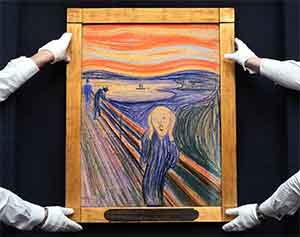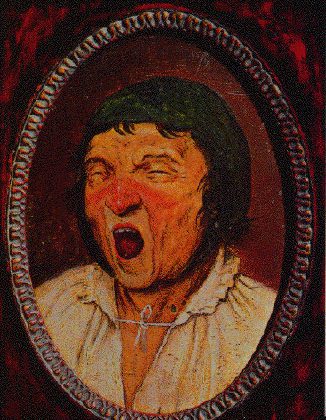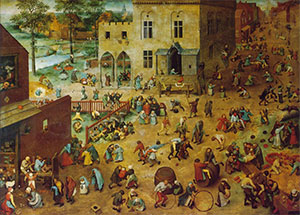All works about Munch: the colours as blood of the human heart; the meaning of the existence

by Prof. Francesco Carelli
University of Milan and Rome
Genoa is one of the three European cities celebrating the 150th anniversary of Edvard Munch’s birth this year with exhibitions aimed at showing to the public the core of the artist’s work, the work he himself appreciated, the themes he was fond of, as well as his favourite techniques.
Oslo, which holds most of Munch’s production together with the rest of Norway, has pursued a holistic approach, whereas Zurich has focused on graphic work. In Genoa, the interpretation of Munch’s work is aimed at refocusing the attention on the artist’s true interest.
Edvard Munch has always enjoyed an amazing success both with art experts and with ordinary people. His work is however rarely exhibited,
since nearly all Munch’s work is kept in a handful of Norwegian museums as well as at the private residences of a very limited group of Norwegian collectors living in a remote village, with very peculiar rules and relationships: neither museums nor collectors are usually willing to lend such heritage, even if it is only for a few months. News reports in the last few years, the most striking of which has been the theft of one of Munch’s work, definitely do not make things easier for artwork loans.
Therefore, the organisation of a Munch exhibition turns out to be a real event, an undoubtedly fascinating challenge but also an incredibly tough one.
Palazzo Ducale in Genoa, together with Arthemisia Group and 24 ORE Cultura – Gruppo 24 ORE, have risen to this challenge not only by organising a Munch exhibition, but also by placing it in the year devoted to celebrations; their aim has been to bring the Norwegian artist back to its original meaning, through a passionate, intimate, delicate, nearly voyeuristic interpretation of his work.
We see Munch through Munch’s eyes, we see what the artist most loved and on which he focused his production: his graphic work, his true interest, masterfully epitomised by wood carvings – exhibited in this show for the first time – or by the very prestigious and unknown Linde collection ( after the family name of the doctor who put Munch up in his countryside residence partially relieving his troubled soul), and the most intimate oil paintings, from portraits to landscapes.
The complexity of the man and of his “inverse” artistic path can be best explained by pointing out that Munch considered painting as a preparatory work for graphic carving. The different carvings of the “Madonna”, an iconic and symbolic Munch’s work on display in the Genoa exhibition, are the end result of a long preparatory work carried out in painting. As a matter of fact, for him the painting was the “draft”, whereas the carving was the true work.
Munch is known worldwide for The Scream; however, The Scream is a sort of “slip-up”; it happens so often that artists from any category (art, cinema, literature) become famous for an “iconic” work that ends up being even rejected in some cases.
The largest part of Munch’s production, the artist’s true work, the work that he himself considered “worth selling”, is the one represented by the 80 works exhibited in Genoa. This is precisely the selection criterion adopted by the curator of the exhibition, Marc Restellini, director of the Pinacotheque de Paris, which back in 2009 hosted one of the most successful Munch exhibitions, also focused on the “anti-scream” theme.
Therefore, the Genoa show offers to the public a unique and unprecedented opportunity, i.e. to view works that are usually jealously guarded in the private residences of a handful of lucky owners of Munch’s work. Above all, this exhibition enables visitors to understand the path followed by an artist who has acquired world fame thanks to one piece of art, but who made many more, sublime works, perhaps less famous, but c considered by him as representative of his poetics.
THE EXHIBITION
The exhibition itinerary features Munch’s artistic development through 80 works as well as a story divided into 8 sections.
“Munch paints what he sees – Marc Restellini argues – but beside his fears he also shows a new vision of art which is pure avant-garde; this show exhibits his most beautiful, deeply-felt, loved and pained works”.
The first and second sections feature his early work under the influence of the school. His landscapes are sometimes naturalistic, some other times borrowed from Impressionism. His faces are truthful, with a hint of austerity and a sort of unasked question in their firm, inquisitive gazes. All these works feature very precise, accurate strokes. Over time strokes will become mobile, quick and caked with colour in some cases, with sorrowful graphic signs in others. Yet, these early self-portraits already hint at the intention to investigate the soul, to subject one’s image to a careful inspection.
The third section covers carvings, Vampires and Madonna’s caught in a single moment, with tragic, staring, gloomy eyes. The prevailing colours are red and black, i.e. life and death. The portrayed subjects are the same of his later years, when, as he predicted as a young man, chasing his future, “arte is the blood of the human heart”. When brush and oil become too light, Munch portrays the same subject, stubbornly, through the carving technique, where he discovers his true expressiveness.
The fourth session is devoted to Symbolism, a well-known movement to Munch and one that he resorted to in some of his work. However, Munch’s very personal style and expression in Symbolism have made him to a certain extent a forerunner of Expressionism. Mindful of Gauguin’s teachings, he reinvents nature, which for him is “the opposite of art; it is the means, not the end”. In these works he tests the experimentation potential offered by tools such as the alternation between opacity and transparency in layers of colour; furthermore, he attacks the material, scratching and scraping it; he ends up using colour itself with the utmost lightness and smoothing out the canvas surface, in the impressionist and post-impressionist way.
The fifth section collects all works belonging to the “bright” period, when Munch spent most of 1904 winter at doctor Max Linde’s home in Lübeck. At the Linde’s Munch is met by a family environment he has never come across before until then. He paints the portrait of the parents and of their four children. He sketches the Linde’s garden, residence and statues surrounding it. He portrays the children individually and as a group. He attempts to be a normal man and painter.
The sixth section features Munch’s work during his hermitage in his Ekely estate. In 1930 an eye disease results into his near blindness and in this late years he works on many self-portraits, as if trying to find out the meaning of his existence, first and foremost. As a matter of fact, each portrait produced by Munch features this spasmodic search, because in spite of the placid poses of some of his models, the violent colour hues and the Angst remind us of how everything fluctuates in a present time that is already progressively dissolving.
The last halls show Munch’s female universe.
His mother had brown hair, his sisters were blond. The same as his girls on the bridge. In his family portraits, women are depicted with their hands in their lap, in peaceful poses. And then there are the women of his life, his lovers, his fiancée: red-haired women who resemble snakes, hidden hands, bust leaning forward, as if Munch – through nude – was trying to test the relation between his model’s poses and colour.
Munch, secluded in his Ekely estate, will continue to paint female bodies until the end of his life.




